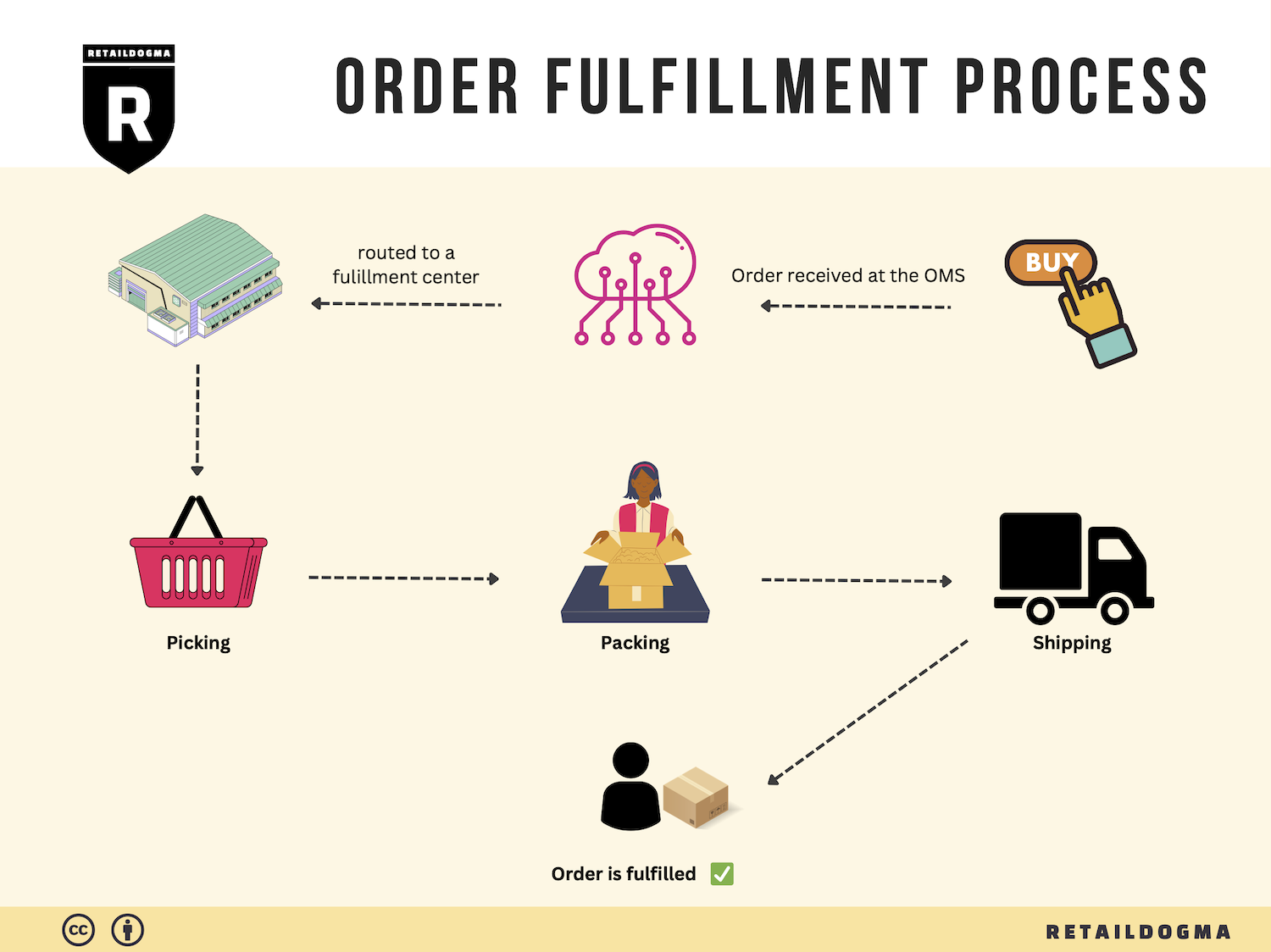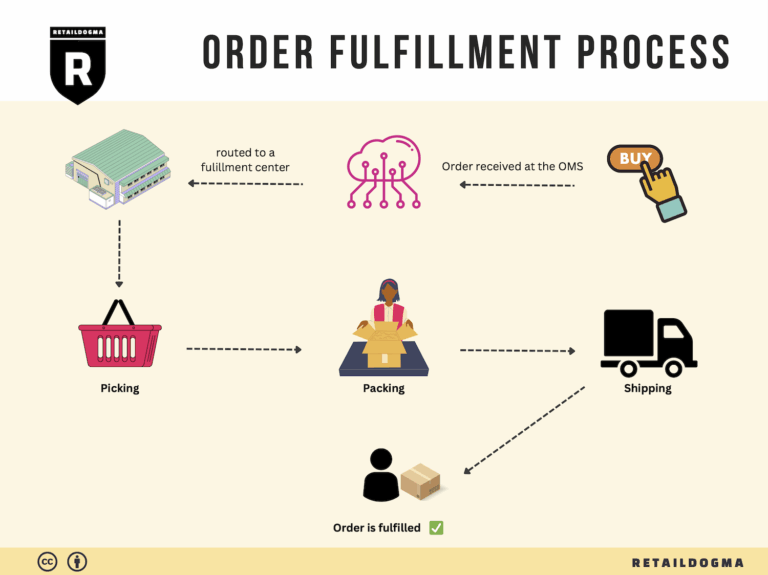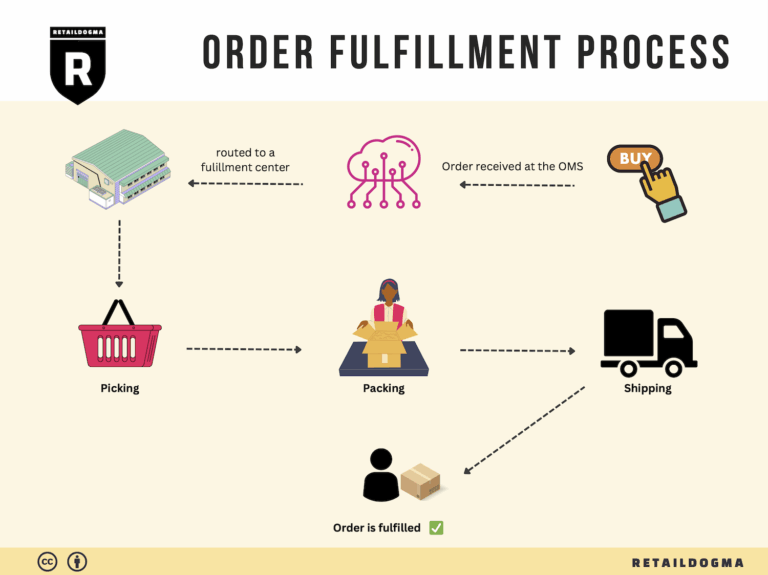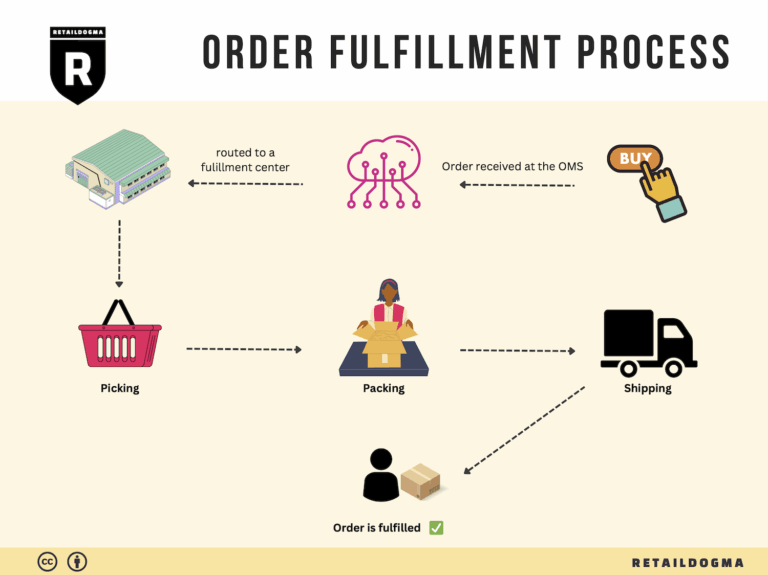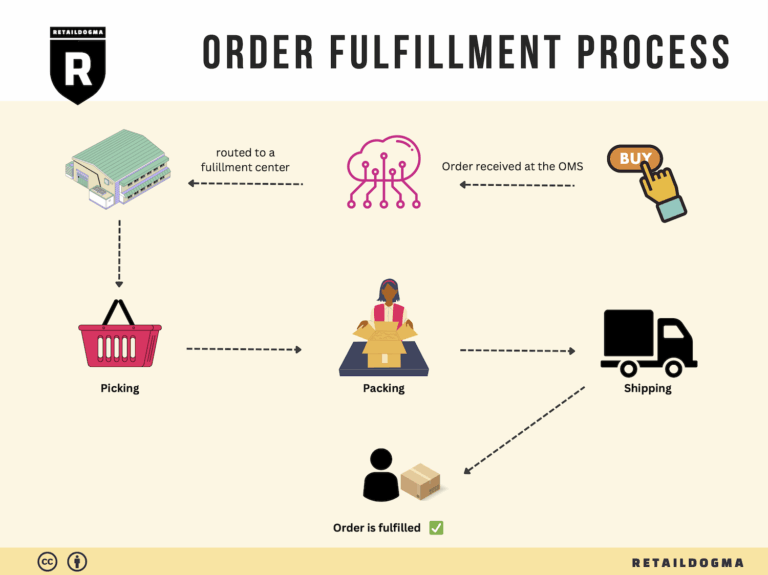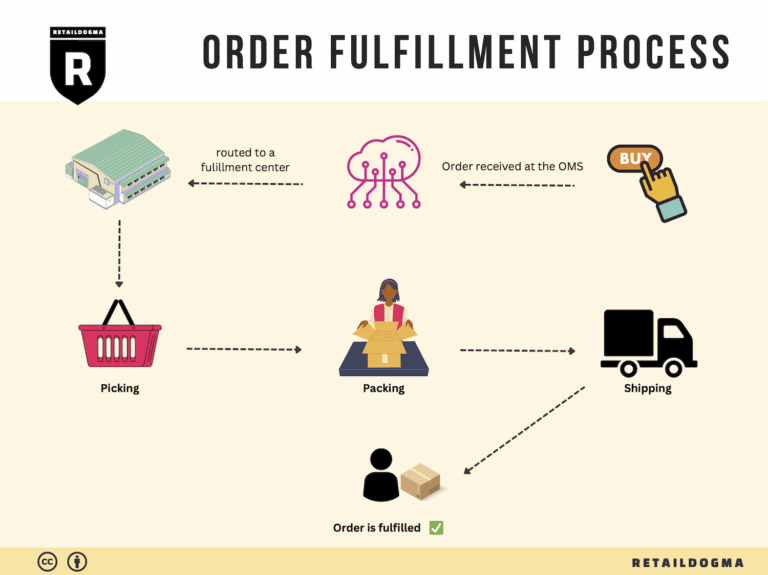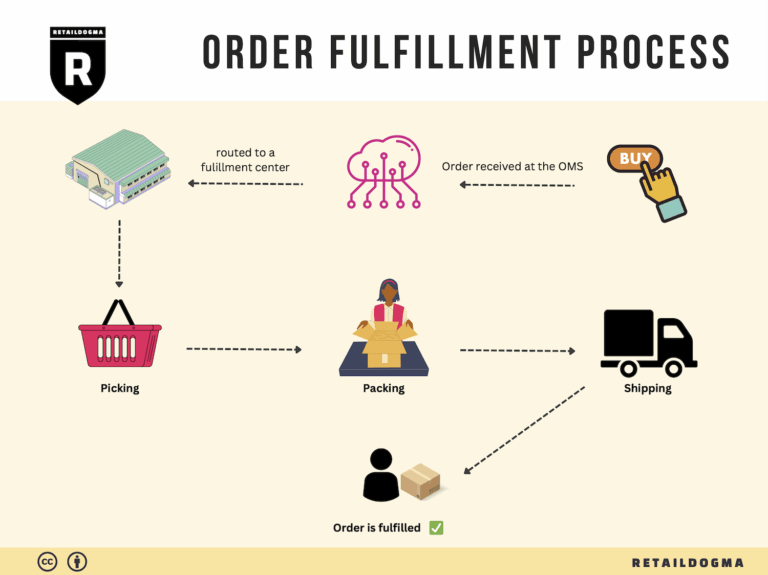Ecommerce Fulfillment Services: The Ultimate Guide (2025)
What is E-commerce Fulfillment? An Introduction for Growing Businesses
Understanding the Challenges of E-commerce Fulfillment
As an e-commerce business owner, you may often find yourself grappling with the complexities of packing and shipping orders. The excitement of growing sales can quickly turn into overwhelm when faced with the logistics of fulfillment. From managing inventory to ensuring timely delivery, the operational demands can distract you from your core mission: growing your business. This is where an effective e-commerce fulfillment strategy becomes crucial.
What is E-commerce Fulfillment?
At its essence, e-commerce fulfillment is the process of getting a product from your warehouse to your customer’s doorstep. It encompasses a variety of tasks, including inventory management, order processing, packing, shipping, and returns handling. Each of these steps plays a critical role in customer satisfaction and overall business efficiency.
What This Guide Covers
In this comprehensive guide, we will explore the different fulfillment models available to you, such as Third-Party Logistics (3PL) and Fulfilled by Amazon (FBA). Understanding these models will help you determine which approach aligns best with your business needs and growth plans.
We will also delve into the core services that fulfillment partners typically offer. This includes not just storage and shipping, but also value-added services like order tracking, customer service, and return management. Knowing what to expect can simplify the decision-making process as you evaluate potential partners.
Choosing the right fulfillment partner is another critical aspect we will address. Factors such as location, technology capabilities, service level agreements, and scalability are essential considerations that can impact your operational efficiency and customer experience.
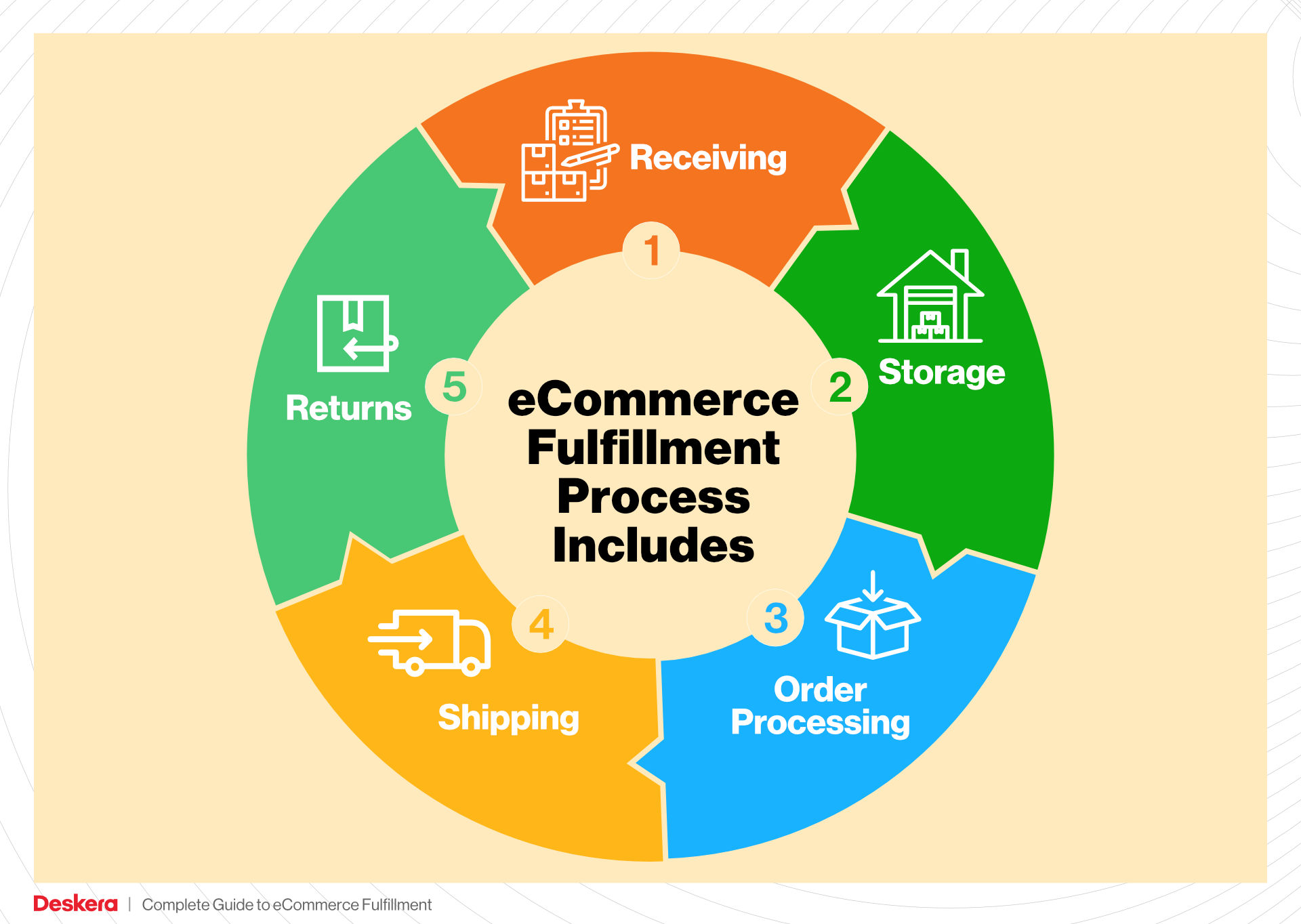
Finally, we’ll provide insights on pricing structures and how to navigate costs associated with fulfillment services. Understanding the financial implications will empower you to make informed choices that support your business’s bottom line.
Empowering Smart Decisions
Our goal with this guide is to equip you with the knowledge you need to make smart, strategic decisions about your logistics operations. By understanding the nuances of e-commerce fulfillment, you can streamline your processes, enhance customer satisfaction, and ultimately drive growth in your business. Let’s embark on this journey to demystify e-commerce fulfillment and set your business up for success.
What You’ll Learn In This Guide
- What is E-commerce Fulfillment? An Introduction for Growing Businesses
- The Order Fulfillment Process: From ‘Buy’ Button to Customer’s Door
- Comparing Fulfillment Models: In-House vs. 3PL vs. Dropshipping
- A Deep Dive into Amazon FBA: Pros, Cons, and Who It’s For
- Core Services Offered by Fulfillment Centers
- How to Choose a Fulfillment Partner: A 6-Point Checklist
- Understanding Fulfillment Pricing: A Breakdown of Common Fees
- Frequently Asked Questions (FAQs) about Fulfillment
- Conclusion: Is Outsourcing Fulfillment the Right Move for Your Business?
- Important Disclaimer
The Order Fulfillment Process: From ‘Buy’ Button to Customer’s Door
1. Receiving Inventory
The first step in the order fulfillment process is receiving inventory. This stage involves the physical arrival of products at the fulfillment center, which can be an Amazon facility like PHL7 or any other logistics hub. Upon arrival, each shipment undergoes a thorough inspection to ensure that it matches the purchase order specifications in terms of quantity and quality.
Why It’s Important: Proper receiving is crucial for maintaining inventory accuracy and preventing stock discrepancies. Any errors made during this step can lead to stockouts or overstock situations, both of which can disrupt operations and affect customer satisfaction.
Key Term: SKU (Stock Keeping Unit) – Each product is assigned a unique SKU, which helps in tracking inventory throughout the fulfillment process. Accurate SKU management ensures that the right products are received and stored.
2. Warehouse Storage
Once the inventory is received and verified, it is moved to designated storage locations within the warehouse. This step involves categorizing products and placing them in specific locations for easy access. Efficient warehouse layout and organization are key factors that influence the overall speed and efficiency of the fulfillment process.
Why It’s Important: Proper storage not only maximizes space utilization but also minimizes the time required to locate items during the picking process. An organized warehouse contributes to quicker turnaround times and enhances operational efficiency.
Key Term: Bin Location – Each item is assigned a specific bin location within the warehouse, which simplifies the inventory management process and facilitates faster picking.
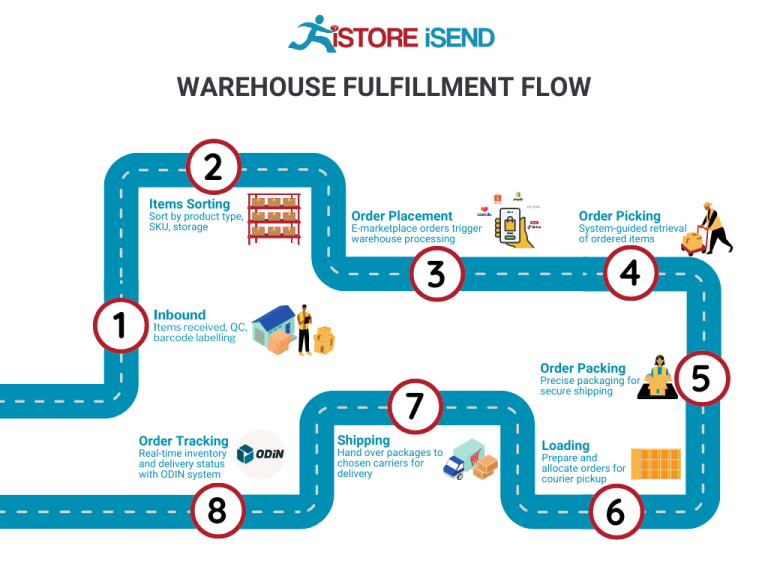
3. Order Picking
Order picking is the process of selecting items from their storage locations to fulfill a customer’s order. This can be done using various methods, such as single-order picking (picking items for one order at a time) or batch picking (picking items for multiple orders simultaneously).
Why It’s Important: This step directly impacts order accuracy and fulfillment speed. Efficient picking processes can significantly reduce the time it takes to get an order ready for shipping, which is crucial for meeting customer expectations, especially in the era of fast shipping.
Key Term: Pick Lists – These are generated to guide warehouse workers on which items to pick for each order. An effective pick list system can streamline the picking process and minimize errors.
4. Order Packing
After items have been picked, they are taken to the packing station. In this step, products are carefully packed for shipment. This involves choosing the right packaging materials, ensuring items are secure, and labeling the package correctly for delivery.
Why It’s Important: Proper packing is essential for protecting products during transit and ensuring they arrive in perfect condition. It also affects shipping costs; efficient packing can reduce dimensional weight charges, which is a significant factor in shipping expenses.
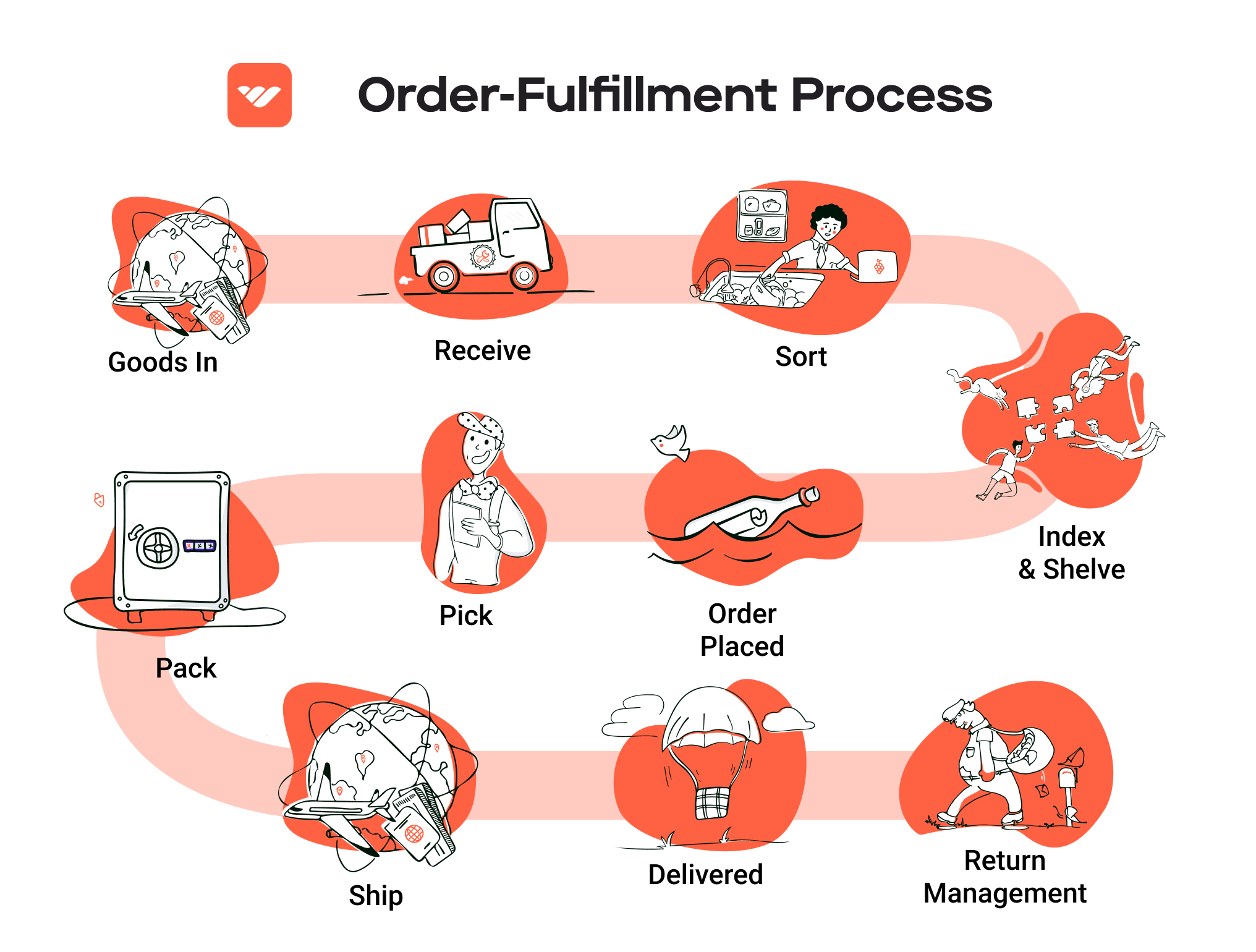
Key Term: Packaging Slip – This document accompanies the order and lists the items included in the shipment. It serves as a confirmation of the order contents and can enhance customer satisfaction by providing transparency.
5. Shipping & Delivery
The final step in the order fulfillment process is shipping and delivery. Once the order is packed, it is handed over to a carrier for transportation to the customer’s address. This step may involve various shipping options, from standard ground shipping to expedited services, depending on the customer’s preferences and the fulfillment center’s capabilities.
Why It’s Important: The shipping process is the last touchpoint in the customer experience and can significantly influence customer satisfaction. Timely and accurate delivery can enhance customer loyalty and drive repeat purchases.
Key Term: Last-Mile Delivery – This term refers to the final leg of the shipping process, where the package is delivered from a transportation hub to the final destination. Efficient last-mile delivery is vital for meeting customer expectations in terms of speed and reliability.
By understanding and optimizing each of these steps in the order fulfillment process, e-commerce businesses can enhance their operational efficiency, reduce costs, and ultimately improve customer satisfaction.
Comparing Fulfillment Models: In-House vs. 3PL vs. Dropshipping
Fulfillment Model Comparison
| Model | Who Handles Inventory | Best For (Business Stage) | Key Advantage | Key Disadvantage |
|---|---|---|---|---|
| In-House Fulfillment | The business itself | Established businesses scaling up | Complete control over operations | High overhead costs and complexity |
| Third-Party Logistics (3PL) | A third-party logistics provider | Startups and scaling businesses | Cost-effective and scalable | Less control over inventory and quality |
| Dropshipping | Suppliers or manufacturers | Startups and low-capital businesses | Low startup costs and no inventory risk | Lower margins and potential supplier issues |
In-House Fulfillment
In-house fulfillment refers to when a business manages its own storage, inventory management, and shipping processes. This model is often adopted by established businesses that have the resources and infrastructure to handle fulfillment internally. The key advantage of in-house fulfillment is the complete control it provides over the entire process, allowing businesses to implement custom processes that align with their brand and customer service strategies. Businesses can tailor their packaging, shipping speed, and handling practices to meet specific customer needs and expectations. However, the disadvantages include high overhead costs associated with maintaining warehouse space, staffing, and logistics operations. Additionally, as the business scales, complexities in operations can arise, requiring significant investment in technology and staff training to maintain efficiency.
Third-Party Logistics (3PL)
Third-party logistics (3PL) providers manage logistics and fulfillment on behalf of businesses. This model is ideal for startups and scaling businesses that want to minimize upfront investments in infrastructure and focus on core business activities. The key advantage of using a 3PL is cost-effectiveness; businesses can leverage the provider’s existing infrastructure, technology, and expertise without incurring the overhead associated with in-house operations. This flexibility allows for rapid scaling, as businesses can adjust their logistics needs based on demand without significant capital investment. However, a key disadvantage is the potential loss of control over inventory and quality. Relying on a third party means that businesses must trust the 3PL to uphold their standards for order fulfillment, which can sometimes lead to inconsistencies in service quality or inventory management.
Dropshipping
Dropshipping is a fulfillment model where retailers sell products without holding inventory. Instead, when a customer places an order, the retailer purchases the item from a third-party supplier who then ships it directly to the customer. This model is particularly attractive to startups and businesses with limited capital because it eliminates the need for inventory investment and storage space. The primary advantage of dropshipping is the low startup costs and reduced financial risk; businesses only pay for products after they make a sale, minimizing cash flow concerns. However, dropshipping can also present significant challenges, such as lower profit margins due to reliance on supplier pricing and the potential for issues with order fulfillment quality and timing. Additionally, businesses have less control over product quality and customer experience, as they are dependent on third-party suppliers to manage these aspects effectively.
Conclusion
Choosing the right fulfillment model is crucial for e-commerce businesses, particularly as they seek to scale. In-house fulfillment offers control but comes with higher costs and complexity. 3PL provides a balance of flexibility and cost-effectiveness, making it suitable for many growing businesses. On the other hand, dropshipping offers low-risk entry into e-commerce but can compromise margins and quality. Understanding the strengths and weaknesses of each model can help business owners make informed decisions that align with their operational capabilities and growth strategies.
A Deep Dive into Amazon FBA: Pros, Cons, and Who It’s For
Understanding Fulfillment by Amazon (FBA)
Fulfillment by Amazon (FBA) is a service that allows e-commerce sellers to leverage Amazon’s extensive logistics network to store, pack, and ship their products. When sellers use FBA, they send their products to Amazon’s fulfillment centers, where Amazon takes care of the rest, including inventory management, order processing, and customer service. This service not only enhances the seller’s operational efficiency but also provides access to Amazon’s vast customer base.
How FBA Works
-
Inventory Shipment: Sellers prepare their products and ship them to Amazon fulfillment centers. Amazon provides guidelines on how to package and label items to ensure compliance.
-
Storage: Once received, products are stored in Amazon’s warehouses. Sellers can monitor inventory levels through their Amazon Seller Central accounts.
-
Order Processing: When a customer places an order for an FBA product, Amazon automatically handles the order fulfillment. This includes picking the product from the shelf, packing it, and shipping it directly to the customer.
-
Customer Service: Amazon manages all customer inquiries and returns for FBA products, allowing sellers to focus on growing their businesses rather than handling customer service issues.
-
Returns Management: Amazon also processes returns on behalf of the seller, ensuring a seamless experience for customers.
Pros of Fulfillment by Amazon
1. Prime Eligibility
One of the most significant advantages of using FBA is the ability to offer products with Amazon Prime eligibility. Prime members enjoy fast, often free shipping, which can significantly enhance conversion rates. Products that are Prime-eligible tend to rank higher in search results, leading to increased visibility and sales.
2. Customer Trust
Amazon is synonymous with reliability and trustworthiness. By using FBA, sellers benefit from the credibility associated with the Amazon brand. Customers are more likely to purchase products fulfilled by Amazon due to the perceived assurance of quality and service.
3. Multi-Channel Fulfillment
FBA is not limited to sales on Amazon alone. Sellers can use FBA to fulfill orders from their own websites or other sales channels. This multi-channel fulfillment capability allows businesses to streamline their operations and manage inventory more effectively across various platforms.
4. Scalability
FBA allows businesses to scale their operations without the need to invest heavily in warehousing and logistics. As sales grow, sellers can increase their inventory levels at Amazon’s fulfillment centers without the hassle of managing storage and shipping logistics themselves.
5. Reduced Shipping Burden
By outsourcing fulfillment to Amazon, sellers can significantly reduce the burden of managing shipping logistics. This frees up time and resources, allowing sellers to focus on product development and marketing strategies.
Cons of Fulfillment by Amazon
1. High Fees
While FBA offers numerous benefits, it also comes with a cost. Amazon charges fees for storage and fulfillment services. These fees can add up quickly, especially for sellers with low-margin products or those who hold inventory for extended periods.
2. Strict Inventory Rules
Sellers must adhere to Amazon’s strict inventory management policies, including limitations on the number of units that can be stored in fulfillment centers. This can pose challenges for sellers with fluctuating demand or seasonal products, as they risk incurring long-term storage fees for unsold inventory.
3. Commingling Risks
With FBA, Amazon may commingle inventory from different sellers to optimize storage space. This means that a seller’s products could be mixed with those of others. In the event of a return or quality issue, this can lead to complications in tracking inventory and managing customer service.
4. Loss of Control
Sellers who use FBA relinquish a degree of control over their inventory and fulfillment processes. This can be concerning for businesses that prefer to manage their own shipping and customer interactions.
5. Potential for Increased Competition
With FBA, many sellers can list similar products, leading to increased competition. This can drive down prices and affect profit margins, especially in saturated markets.
Who is FBA Best For?
Fulfillment by Amazon is particularly beneficial for:
-
Small to Medium-Sized Businesses: Sellers looking to scale their operations without significant upfront investment in logistics will find FBA a viable option.
-
E-commerce Startups: New businesses can leverage FBA to gain quick access to Amazon’s vast customer base and benefit from its trusted reputation.
-
Sellers with High-Volume Products: Businesses that have products with consistent demand will benefit from the economies of scale that FBA offers.
-
Multi-Channel Sellers: Businesses selling across various platforms can streamline their logistics by using FBA for all order fulfillment.
-
Sellers Seeking Efficiency: For those who want to focus more on marketing and product development rather than logistics, FBA provides a comprehensive solution to manage fulfillment efficiently.
In conclusion, while Fulfillment by Amazon offers a powerful suite of benefits for e-commerce businesses, it is essential for sellers to carefully weigh the pros and cons. Understanding how FBA fits into their overall business strategy is crucial for maximizing its potential and ensuring long-term success.
Core Services Offered by Fulfillment Centers
Inventory Management & Warehousing
Inventory management and warehousing are foundational services provided by fulfillment centers. This process involves the systematic tracking and storing of products within a dedicated warehouse space. Fulfillment centers use advanced inventory management systems to monitor stock levels, track product movements, and forecast inventory needs based on sales trends.
Benefits:
1. Real-Time Inventory Visibility: E-commerce businesses can gain real-time insights into their inventory levels, which helps in making informed purchasing decisions and avoiding stockouts or overstock situations.
2. Optimized Space Utilization: Fulfillment centers typically employ sophisticated storage solutions, maximizing warehouse space and ensuring that products are stored in an organized manner for easy retrieval.
3. Scalability: As a business grows, fulfillment centers can quickly adapt to increased inventory demands without the need for businesses to invest in additional warehouse space or management systems.
Pick and Pack Services
Pick and pack services are crucial for fulfilling customer orders efficiently. In this process, fulfillment center staff receive orders, locate the products in the warehouse, and package them for shipping. This service often includes quality checks to ensure that the correct items are selected and packed securely.
Benefits:
1. Speed and Efficiency: Fulfillment centers are designed to streamline the picking and packing process, reducing the time it takes to fulfill orders. This efficiency is particularly important for e-commerce businesses that rely on fast shipping to enhance customer satisfaction.
2. Accuracy in Order Fulfillment: With trained staff and automated systems, fulfillment centers can minimize errors in order processing, leading to higher customer satisfaction and reduced return rates.
3. Custom Packaging Options: Many fulfillment centers offer custom packaging solutions, allowing businesses to enhance their branding and improve the unboxing experience for customers.
Kitting and Assembly
Kitting and assembly services involve bundling individual items together into ready-to-ship products. This service is particularly beneficial for businesses that offer complex products or promotional bundles, as it allows for the pre-assembly of items before they are shipped to customers.
Benefits:
1. Reduced Preparation Time: By outsourcing kitting and assembly to a fulfillment center, e-commerce businesses can save time and labor costs associated with preparing products for shipment.
2. Increased Sales Opportunities: Kitting allows businesses to create attractive product bundles, which can increase average order values and entice customers to purchase more.
3. Quality Control: Fulfillment centers typically have quality assurance processes in place to ensure that kitted products meet the desired specifications before they are shipped, reducing the likelihood of customer complaints.
Returns Management (Reverse Logistics)
Returns management is a critical service that encompasses the processes involved in handling returned products. Fulfillment centers facilitate reverse logistics by inspecting, restocking, or disposing of returned items as necessary. This service is essential for maintaining customer satisfaction and managing inventory effectively.
Benefits:
1. Streamlined Returns Process: Fulfillment centers can automate the returns process, making it easier for customers to return items and for businesses to manage those returns efficiently.
2. Data Insights: Analyzing return data can provide valuable insights into product performance, allowing businesses to identify issues with specific items and make informed decisions regarding product offerings.
3. Cost Management: By efficiently processing returns, fulfillment centers can help businesses minimize the costs associated with reverse logistics, including shipping, restocking, and potential loss of revenue due to unsold inventory.
Conclusion
Utilizing a fulfillment center’s core services can significantly enhance the operational efficiency of an e-commerce business. From inventory management and warehousing to pick and pack services, kitting and assembly, and returns management, these services not only streamline logistics but also contribute to improved customer satisfaction and scalability. For e-commerce business owners and operations managers aiming to scale their operations, leveraging the expertise of fulfillment centers can provide a competitive edge in the ever-evolving landscape of online retail.
How to Choose a Fulfillment Partner: A 6-Point Checklist
Location & Warehouse Network
Why It’s Important:
The geographical location of your fulfillment partner’s warehouses directly impacts shipping times, costs, and overall customer satisfaction. A partner with strategically placed warehouses can ensure faster delivery to your customers, reducing shipping expenses and enhancing service levels.
Questions to Ask:
– Where are your warehouses located, and how does this align with our primary customer base?
– What is your average shipping time to major markets?
– Do you have a network of fulfillment centers that can support multi-channel distribution?
– How do you handle international shipping, if applicable?
Technology & Integrations
Why It’s Important:
A robust technology platform is essential for seamless operations, real-time inventory management, and efficient order processing. The right technology should integrate with your e-commerce platform, ensuring smooth data flow between systems.
Questions to Ask:
– What technology do you use for inventory management and order processing?
– Can your systems integrate with our existing e-commerce platform (e.g., Shopify, Magento, Amazon)?
– Do you offer real-time tracking for orders and inventory?
– How do you manage data security and compliance with regulations?
Specializations (e.g., cold storage, oversized items)
Why It’s Important:
Your business may have specific requirements such as handling temperature-sensitive products, oversized items, or hazardous materials. A fulfillment partner that specializes in your product type can provide tailored services that meet regulatory standards and ensure product integrity.
Questions to Ask:
– Do you have specialized facilities for unique product categories (e.g., cold storage, fragile items)?
– What certifications do you hold for handling specialized products?
– How do you manage compliance with industry-specific regulations?
– Can you provide case studies or references for similar businesses you’ve supported?
Scalability & Capacity
Why It’s Important:
As your business grows, your fulfillment needs will likely change. A partner that can scale operations quickly will help you manage fluctuations in demand, seasonal spikes, or expansion into new markets without disruption.
Questions to Ask:
– What is your current capacity for handling orders, and how do you plan to scale in the future?
– How do you manage peak seasons or unexpected surges in order volume?
– Are there any limitations on the types or quantities of products you can fulfill?
– Can you accommodate our growth over the next 1-3 years?
Pricing and Contracts
Why It’s Important:
Understanding the pricing structure and contract terms is crucial for budgeting and financial planning. Transparent pricing helps avoid unexpected costs that can erode profit margins.
Questions to Ask:
– What is your pricing model (e.g., per order, per item, monthly fees)?
– Are there any hidden fees (e.g., storage, handling, returns)?
– What are the contract terms, and is there flexibility for scaling up or down?
– How do you handle pricing adjustments in the case of changing market conditions?
Customer Support & Reviews
Why It’s Important:
Effective customer support is vital for addressing issues quickly and maintaining operational efficiency. Partnering with a provider that has a strong reputation for customer service can save you time and resources.
Questions to Ask:
– What support channels do you offer (e.g., phone, email, chat)?
– What are your average response times for customer inquiries?
– Can you provide references or testimonials from current clients?
– How do you handle order discrepancies or customer complaints?
Conclusion
Choosing the right fulfillment partner is a critical decision that can significantly impact your e-commerce operations. By following this checklist, you can assess potential partners against key criteria that will support your business goals. Take the time to conduct thorough research and ask the right questions to find a partner that aligns with your specific needs and can help you scale effectively.
Understanding Fulfillment Pricing: A Breakdown of Common Fees
Initial Setup Fees
Initial setup fees are typically charged when you first establish an account with a fulfillment service provider. These fees cover the cost of onboarding, including account setup, systems integration, and any necessary training. The specific amount can vary widely depending on the provider and the complexity of your operations.
- Calculation: Initial setup fees may range from a few hundred to several thousand dollars. Factors influencing this cost include the provider’s infrastructure, the level of customization required, and the volume of products you plan to store and ship.
Receiving Fees
Receiving fees are charged for the process of accepting and processing your inventory when it arrives at the fulfillment center. This fee typically covers the labor and resources needed to unload, inspect, and store your goods.
- Calculation: These fees can be calculated per shipment or per pallet. For example, some providers may charge a flat rate for each shipment received, while others might charge based on the number of pallets or the total weight of the shipment. Expect to pay anywhere from $20 to $50 per pallet or a flat fee of $50 to $150 per shipment.
Storage Fees (per pallet/bin)
Storage fees are recurring charges applied for holding your inventory within the fulfillment center. These fees can be calculated based on the volume of space your products occupy, typically measured in pallets or bins.
- Calculation: Storage fees can vary based on the time of year, with many providers implementing higher rates during peak seasons (like the holiday season). Generally, you might see charges ranging from $10 to $25 per pallet per month. Bin storage fees are often calculated per square foot and can range from $0.50 to $2.00 per square foot monthly. It’s essential to clarify whether these fees are charged monthly or annually.
Pick & Pack Fees (per item/order)
Pick and pack fees are charges for the labor involved in selecting items from inventory and packing them for shipment. This fee is essential for e-commerce businesses as it directly relates to order fulfillment.
- Calculation: Pick and pack fees are typically charged per item picked or per order processed. For instance, you may encounter fees around $0.50 to $2.00 per item, or a flat fee ranging from $2.00 to $5.00 per order, depending on the complexity of the order. Providers may also implement tiered pricing, where the cost per item decreases as the order volume increases, incentivizing larger orders.
Shipping Fees
Shipping fees encompass the costs associated with transporting your products from the fulfillment center to the customer. This fee can be one of the most variable components of fulfillment pricing.
- Calculation: Shipping fees depend on several factors, including the destination, the weight and dimensions of the package, and the shipping method selected (standard, expedited, etc.). Many fulfillment centers offer discounted shipping rates through partnerships with major carriers, which can be passed on to you. Expect to pay anywhere from $5 to $20 for domestic shipping, with international rates varying significantly based on distance and service level.
Tips for Getting an Accurate Quote
When seeking an accurate quote from fulfillment service providers, consider the following tips:
-
Detail Your Needs: Provide a comprehensive overview of your inventory, including dimensions, weight, and SKU counts. Specify your expected order volumes and any seasonal fluctuations.
-
Ask About Pricing Models: Inquire whether the provider uses flat-rate pricing, tiered pricing, or dynamic pricing based on demand. Understanding their model can help you anticipate costs better.
-
Clarify All Fees: Ensure you understand all potential fees, including hidden costs like returns processing, packaging supplies, and additional services. Request a detailed breakdown of charges.
-
Negotiate Terms: Many fulfillment providers are open to negotiation, especially if you can commit to a long-term contract or a higher volume of business.
-
Compare Multiple Quotes: Don’t settle for the first quote. Compare offers from several providers to identify the best value while ensuring service quality meets your expectations.
By being proactive and thorough in your inquiries, you can better understand the fulfillment pricing landscape and make informed decisions that align with your business goals.
Frequently Asked Questions (FAQs) about Fulfillment
1. What is the PHL7 Amazon Fulfillment Center?
The PHL7 Amazon Fulfillment Center is a large logistics facility located in Middletown, Delaware. It is one of Amazon’s major fulfillment centers, specifically designed to handle and streamline the storage, packing, and shipping of products sold through the Amazon platform. Covering over 1 million square feet, it plays a critical role in Amazon’s supply chain operations in the region.
2. How does the PHL7 center fit into Amazon’s logistics network?
PHL7 is strategically located to optimize shipping times and delivery efficiency for customers in the northeastern United States. It works in conjunction with other fulfillment centers and last-mile delivery networks to ensure timely order fulfillment, which is a key aspect of Amazon’s service promise.
3. What services does the PHL7 Fulfillment Center offer?
The PHL7 center provides a range of services including receiving inventory, storing products, picking and packing orders, and shipping them directly to customers. It utilizes advanced technology and automation to enhance operational efficiency and accuracy in order processing.
4. What is the difference between a warehouse and a fulfillment center?
A warehouse is primarily a storage facility where goods are kept until they are needed, often for bulk distribution. In contrast, a fulfillment center is designed for the complete order processing cycle, which includes inventory management, order picking, packing, and shipping directly to consumers. Fulfillment centers are focused on speed and efficiency to meet the demands of e-commerce.
5. What is a 3PL (Third-Party Logistics)?
A 3PL is a service provider that manages a company’s logistics and fulfillment needs. This can include warehousing, inventory management, order fulfillment, and transportation services. Many e-commerce businesses partner with 3PLs like Amazon to leverage their infrastructure and expertise, allowing them to scale operations without investing in their own logistics capabilities.
6. How much do fulfillment services cost?
Fulfillment service costs can vary widely based on several factors, including the volume of orders, types of products, storage space required, and additional services such as packaging and returns management. Typically, fees may include storage costs, order processing fees, and shipping charges. Businesses should evaluate their specific needs and compare different providers to find the best pricing structure.
7. How can I send my products to the PHL7 Fulfillment Center?
To send products to the PHL7 fulfillment center, you must first set up an Amazon seller account and enroll in the Fulfilled by Amazon (FBA) program. Once enrolled, you can create a shipping plan through your seller account, which will guide you on how to prepare and label your products for shipment to the center.
8. What are the advantages of using the PHL7 Fulfillment Center?
Using the PHL7 Fulfillment Center allows businesses to benefit from Amazon’s extensive logistics network, fast shipping options (including Prime delivery), and advanced inventory management systems. This can lead to improved customer satisfaction, reduced overhead costs, and greater operational efficiency.
9. What technologies are used at the PHL7 Fulfillment Center?
The PHL7 center employs a variety of technologies to enhance its operations, including automated sorting systems, robotics for picking and packing, and sophisticated inventory management software. These technologies help streamline processes, reduce errors, and improve overall fulfillment speed.
10. How does Amazon ensure order accuracy at the PHL7 Fulfillment Center?
Amazon implements rigorous quality control measures at the PHL7 fulfillment center, which include automated scanning systems, regular audits, and employee training programs. These measures are designed to minimize picking errors and ensure that customers receive the correct items in a timely manner.
Conclusion: Is Outsourcing Fulfillment the Right Move for Your Business?
Evaluating the Benefits of Outsourcing Fulfillment
Outsourcing fulfillment can be a transformative decision for e-commerce businesses aiming to scale operations effectively. The primary benefits of leveraging a fulfillment service include significant time savings, enhanced scalability, and access to specialized expertise. By entrusting logistics and order fulfillment to a dedicated partner, business owners can redirect their focus toward strategic growth initiatives, marketing efforts, and customer engagement. This shift not only optimizes operational efficiency but also allows for a more agile response to market demands.
Scalability is another crucial advantage. As your business grows, so do the complexities of managing inventory and shipping logistics. A reliable fulfillment partner can accommodate fluctuations in order volume, ensuring that your operations can expand without the burden of additional overhead costs. This flexibility is vital in today’s fast-paced e-commerce landscape, where consumer expectations for quick and reliable delivery continue to rise.
Moreover, partnering with a fulfillment service often means tapping into their industry expertise. These providers have established systems and processes designed to maximize efficiency and minimize errors, which can lead to improved customer satisfaction and retention.
Choosing the Right Partner for Growth
However, the success of outsourcing fulfillment hinges on selecting the right partner. Not all fulfillment services offer the same level of quality, technology, or customer support. It’s essential to conduct thorough research and due diligence, considering factors such as location, service offerings, and technological capabilities.
Call to Action
To determine if a fulfillment partner is the right next step for your business, take the time to audit your current shipping processes. Analyze your order volumes, shipping times, and customer feedback to identify pain points. This assessment will provide clarity on whether outsourcing fulfillment could enhance your operational efficiency and support your growth ambitions. Don’t hesitate—evaluate your options and consider how partnering with a fulfillment service can elevate your business to new heights.
Important Disclaimer
⚠️ Important Disclaimer
The information in this guide is for educational purposes. Fulfillment services, pricing, and platform features change frequently. Always conduct your own due diligence and consult with providers directly before making business decisions.
